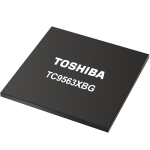
Volume production is planned for April.
The new bridge IC incorporates two 10 Gbps Ethernet Media Access Controller (MAC) supporting a number of interfaces including USXGMII, XFI, SGMII, and RGMII.
Both ports support Ethernet IEEE802.1 audio/video bridging (AVB) for real-time processing and low-latency IEEE802.1 time-sensitive networking (TSN) for synchronous processing. The ports also support “simplified” single root I/O virtualization (SR-IOV) on PCIe devices.
The TC9563XBG includes a PCIe Gen 3 switch with three external ports for communications with the host-controller SoC and additional devices equipped with PCIe interfaces like 5G-modem modules.
The PCIe switch upstream port supports up to four lanes (32GT/s) for connection with the host SoC, whereas, depending on the configuration, the downstream ports can connect with one and two lanes to PCIe-capable devices.
Automotive networks are evolving toward zonal architecture that requires real-time transmission between the zones using multi-gigabit Ethernet communication.
As such, the TC9563XBG with its dual 10 Gbps AVB and TSN capable Ethernet interfaces is ideal for next-generation automotive networking.
As automotive communication requirements increase in terms of the amount of data as well as the required speeds, the new bridge IC will support various automotive applications including in-vehicle infotainment (IVI) and telematics.
It can also replace the existing ethernet-to-PCIe TC9560 and TC9562 bridges, thereby upgrading system throughput and performance.
Recently the use of PCIe interfaces has proliferated for device-to-device communication such as Wi-Fi, often leaving designers short of PCIe interfaces on the host SoC. Using the TC9563XBG’s 3-port PCIe switch function for these connections will address this issue.
Housed in a 10mm x 10mm, 0.65mm pitch P-FBGA package, the TC9563XBG bridge IC will be compliant with AEC-Q100 (Grade 3).
